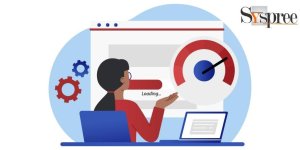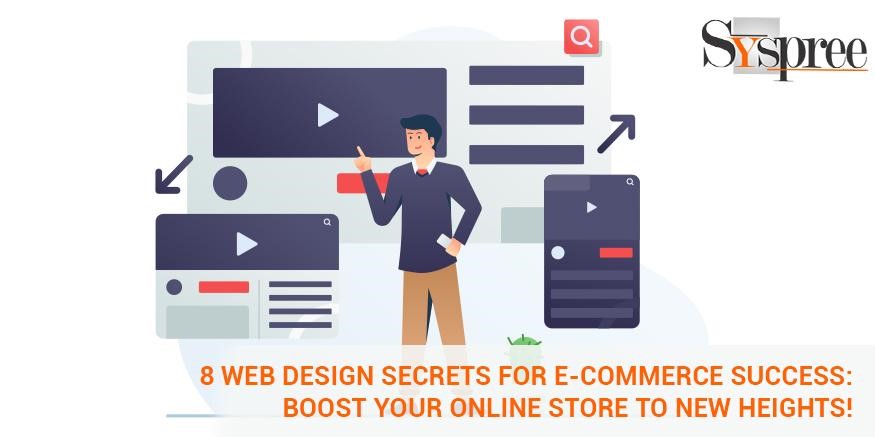We welcome you to our blog, in which we explore the world of Web Design in E-commerce and discover the best methods to take your store’s online presence to new levels. The best web design company states that digital visual appeal and user-friendly sites are no longer a luxury in today’s world.
It’s a requirement for companies that want to be successful in the highly competitive world of e-commerce. If you’re beginning your online business or are looking to redesign your current website, Understanding the significance of web-based design and applying the correct strategies can be the key to enticing customers increasing conversions, and ultimately achieving success.
Key Takeaways
- An attractive and user-friendly site is essential for success in a highly competitive E-commerce market. It establishes the tone for shopping experiences, creates trust, and affects customer perception and interaction.
- Simple and easy navigation, with menus, search capabilities, and well-organized product categories, makes it easy for users to find the information they seek and improves the entire user experience.
- The ability to optimize the Web Design in an E-commerce site to work with mobile devices is crucial because mobile sales and traffic are expected to continue growing. Responsive design provides an uncluttered experience across all screen sizes, improving user experience and engagement.
- Branding and visual appeal Consistent branding elements with high-quality images of products and eye-catching call-to-action buttons increase the aesthetic appeal of your site, build trust and increase conversions.
- The Streamlined Checkout Procedure: Streamlining the checkout process, providing various payment options that are secure and the option of guest checkout, and using progress indicators as well as clear instructions helps decrease cart abandonment and increase conversion rates.
Importance of Web Design in E-commerce
Web Design in E-commerce plays an essential aspect in the performance of an online store. In the highly competitive realm of online shopping, where endless possibilities are just a click away, an appealing and user-friendly site could be the difference.
The appearance of your store’s online presence is often the very first impression your customers have of your brand and establishes the tone for their shopping experience. A well-designed website not just attracts attention and guides them throughout the buying journey and ultimately resulting in higher sales and more satisfaction of customers. It conveys confidence, professionalism, and credibility that inspires prospective buyers to buy.
Furthermore, a successful Web Design in E-commerce is based on aspects like the user experience, responsiveness to mobile devices, navigation ease, and aesthetic appeal. All of these aid in improving the overall experience of customers and increasing the likelihood of repeat business.
In essence, Web Design in E-commerce is not only about aesthetics. It directly affects your store’s online performance by creating a positive impression on customers, engagement, and sales.
9 Secrets for Web Design in E-commerce: Boost Your Online Store to New Heights!
In the present digital world, an attractive and user-friendly website isn’t a luxury but an essential requirement for businesses seeking to be successful in the online marketplace.
If you’re beginning your online business or are looking to redesign your current website, knowing the importance of web layout and applying the correct strategies will make a huge difference in attracting clients, increasing sales, and eventually achieving success.
1. User-Friendly Navigation
The navigation on your Web Design in an E-commerce site is vital in guiding customers throughout their shopping experience. A clear and simple menu structure lets users quickly locate the details or products they seek.
It would help if you thought about organizing your menu in an orderly manner, with main categories and subcategories that are logical to the people you are targeting. Let a leading web design company in Mumbai guide you in improving your website navigation.
In addition, having a practical search feature can dramatically improve your user experience. A search bar that is prominently displayed on your site allows visitors to search quickly for specific items or data. Ensure that the search results are accurate, relevant, and presented in a user-friendly format.
To make navigation easier, Organizing product categories in a well-organized manner is crucial. Sort similar products together using clear and precise labels to aid users in understanding the information contained in each category. Think about using filters or sorting options that allow users to narrow the results of their searches based on specific criteria, such as size, price range, color, or even brand.
2. Mobile Responsiveness

Mobile Responsiveness
In the age of mobiles, the need for a mobile-friendly website is no longer an option but essential. Mobile devices are responsible for a large amount of online traffic and sales, which is why it’s essential to optimize your online store’s website to be mobile-friendly.
Mobile-friendly design is all about providing an effortless and enjoyable user experience across various devices and sizes of screens. Responsive layouts ensure that your site adapts and scales well, giving users optimal interaction and view regardless of the device they’re using. It reduces the need to scroll horizontally or zoom in, making navigation a breeze for mobile users.
You should consider using adaptive elements that can adjust according to the screen’s size. These include appropriately sized buttons and text that is easily readable and images that load fast without losing quality. Optimizing your site’s interface for touch interaction is crucial, considering that mobile users typically navigate via swipes and taps. Allow the most creative digital marketing company to assist you in creating a responsive web design,
3. Visual Appeal and Branding
To establish a solid and memorable online presence, you must incorporate uniform branding elements across your website. This means including colors, your brand logo, and typography consistent with your brand’s identity. Consistent branding builds confidence and trust among your customers, making your store’s online presence more memorable.
One of the primary aspects of Web Design in E-commerce visuals is the high-quality images of products. Visually appealing and clear images can greatly influence a consumer’s decision-making process. The best digital marketing agency Singapore can help you work in color theory.
Consider investing in professional product photography or using high-resolution images that show your product in the most appealing light. Ensure the images are optimized to speed up loading without sacrificing quality.
Another crucial aspect of visually appealing is successfully using the call-to-action (CTA) button. These buttons must be attractive and clearly convey your desired actions, such as “Add to Cart” or “Buy Now.” Use contrast colors, clear and action-oriented words, and strategically placed ones to create CTAs stand out and inspire customers to take the desired action.
4. Streamlined Checkout Process

Streamlined Checkout Process
A smooth checkout procedure is vital to the reduction of cart abandonment as well as to improving conversion rates. Reducing the checkout process will reduce friction and provide a more satisfying customer experience. Here are some important considerations:
-
Simple and Secure Payment Options:
Provide a wide range of safe methods of payment that can be easy for your customers. The most popular options are credit/debit cards, digital wallets, and payments made online. Make sure the payment process is secure and seamless and supports SSL encryption to safeguard private customer information.
-
Guest checkout option:
not everyone would like to sign up for an account during check-out. Offer a guest checkout option that allows customers to purchase items without registration. But, you should consider providing incentives to sign up for an account, like exclusive discounts or personalized suggestions, to encourage customers to sign up.
5. Product Page Optimization
One of the primary elements of optimizing a page for a product is providing detailed and precise product descriptions. Customers rely on product descriptions to learn about the characteristics, specifications, and benefits of products they’re interested in.
Ensure your product descriptions are concise, easy to comprehend, and highlight each item’s distinctive benefits. Use subheadings, bullet points, and other formatting techniques to make your information accessible.
Integrating customer reviews and ratings on your website’s pages can boost trust and increase credibility. Show genuine reviews written by previous customers to give evidence of social connections and help prospective buyers make informed decisions.
Consider implementing a rating program that lets customers give their opinions and ratings on products and leave feedback. A brilliant web design company believes that positive reviews may boost the chances of conversions, whereas negative reviews can offer valuable feedback to improve the product.
6. Page Load Speed Optimization

Page Load Speed Optimization
The speed of loading pages is an important element that directly affects the users’ experience and conversion. A slow-loading page can cause frustration and lead users to leave your website. Here are some strategies for optimizing your site to ensure that your site loads quickly speeds:
-
The importance of fast loading speeds:
Research has shown that even a single-second delay in loading time could result in increased bounce rates and fewer conversions. Users expect immediate access to information, and ensuring your site is optimized to speed up loading is essential. A leading web design company in Mumbai can help you improve your website speed.
-
Image compression and optimization:
Images with large file sizes could significantly impact the loading times of pages. Make your photos more efficient by compression without damaging the quality. Choose image formats that provide more compression, such as JPEG and WebP. Also, use lazy loading to load images only after they appear in the viewer’s viewport.
-
Minifying CSS and JavaScript Minimizing:
CSS or JavaScript files are about eliminating unneeded characters, spaces, and line breaks. This can decrease file size and speed up loading times. Utilize plugins or tools to automatically reduce these files’ size and ensure they’re optimized for speedy delivery.
7. Trust and Security
Building trust is crucial to the success of online businesses. Customers require assurance that their data and transactions are safe. Here are the best ways to build confidence:
- SSL certificate and secure checkout: Use Secure Sockets Layer (SSL) encryption on your site to safeguard customer information when they make online transactions. Show the trust indicator, like padlocks or HTTPS icons in the URL, to indicate an encrypted checkout process.
- Trust Seals and Badges: Display reliable providers’ trust seals and badges, like Norton Secured or McAfee Secure, to inspire customer trust. These symbols signal that your business complies with strict security standards.
- Privacy Policies and Terms of Service: It is imperative to clearly state the privacy policies of your store and terms of service. This will provide information on how customers’ data is processed and protected. Customers can be assured that their personal information is handled with respect.
8. Complete Integration with Marketing Tools

Complete Integration with Marketing Tools
- Email Marketing Integration: Connect your store’s website to email marketing services like Mailchimp and Constant Contact. This integration lets you create and manage a customer list of email addresses, to automate email marketing campaigns and deliver specific promotional offers. Get the help of the most efficient digital marketing company to integrate email marketing.
- Social Media Integration: Connect your store with popular social media platforms like Facebook, Instagram, or Pinterest. This integration lets you display your items, interact with customers, and drive traffic from social media to your store’s website.
- Conversion Tracking and Analytics: Use tools for website analytics, such as Google Analytics, to track and examine the behavior of users, traffic sources, and conversion and other rates. These insights will help you to identify the preferences of customers and help you optimize how you market.
Personalization: Creating a Tailored User Experience for E-commerce Success
Customization and personalization are the key factors in creating an appealing and memorable user experience for an E-commerce site. In the current competitive marketplace, consumers expect a customized experience tailored to their preferences and needs.
The best digital marketing agency Singapore states that by utilizing personalization strategies like specific and personalized product recommendations, you can provide more personalized and relevant customer shopping experiences.
Using customer information such as the history of purchases, browsing habits, and other demographic information, You can provide engaging content that is a hit with every particular user.
Conclusion:
Implementing effective Web Design in E-commerce is essential to ensure success for your E-commerce. By focusing on a user-friendly interface, mobile responsiveness, appealing design, speedy checkout procedures, and continuous testing, you can improve your online store and achieve more conversions. Discover the secrets to success and elevate the online shop to more significant levels! If you enjoyed reading this blog, be sure to read the previous blog on LinkedIn Algorithm Changes: Boosting Your Posts for Increased Engagement.







